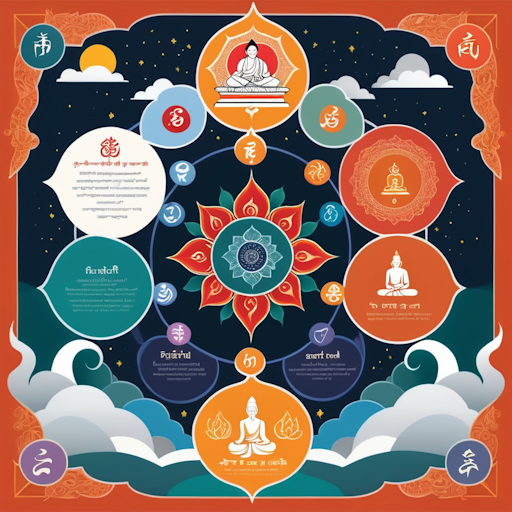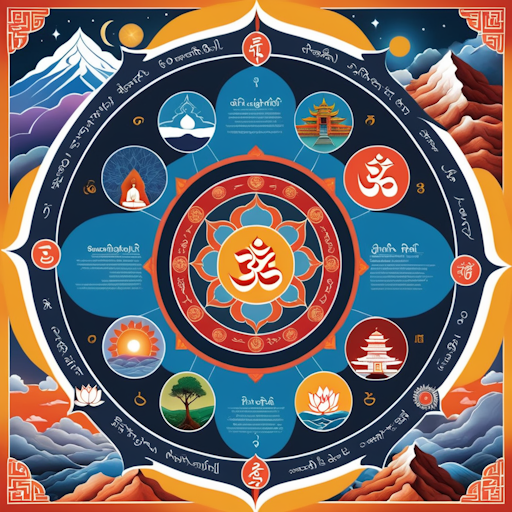Buddhism, one of the world’s oldest and most influential spiritual traditions, offers profound insights into the human condition and a path to liberation from suffering. At the heart of Buddhist philosophy lies the Eightfold Path, a set of ethical and mental principles that guide practitioners towards a life of wisdom, morality, and inner peace. In this article, we will embark on a journey of exploration, delving into the nuances of each path within the Eightfold Path in Buddhism, providing practical tips for applying these principles in daily life, and sharing inspiring stories of individuals who have followed this transformative path.
In-Depth Exploration of Each Path
The Eightfold Path is divided into three categories: wisdom, ethical conduct, and mental discipline. Within each category, there are specific paths to follow. Let’s explore each one in detail.
Wisdom (Prajna):
- Right Understanding (Samma Ditthi): This path involves developing a deep understanding of the nature of reality, which includes recognizing the impermanence of all things, the concept of suffering (Dukkha), and the absence of a permanent self (Anatta). Right understanding lays the foundation for the other paths.
- Right Intention (Samma Sankappa): Right intention focuses on cultivating wholesome intentions, such as goodwill, compassion, and a commitment to non-harming. It involves aligning one’s thoughts and intentions with the principles of kindness and compassion.

Ethical Conduct (Sila):
- Right Speech (Samma Vaca): Right speech emphasizes the importance of truthful, kind, and helpful communication. It encourages practitioners to avoid lying, harsh words, divisive speech, and gossip.
- Right Action (Samma Kammanta): Right action relates to ethical behavior in one’s actions. It involves refraining from actions that harm others, such as killing, stealing, and sexual misconduct.
- Right Livelihood (Samma Ajiva): Right livelihood addresses the importance of earning a living through ethical means. It encourages practitioners to engage in work that does not harm others or contribute to suffering.

Mental Discipline (Samadhi):
- Right Effort (Samma Vayama): Right effort involves cultivating positive mental states and eliminating negative ones. It encourages practitioners to be diligent in their pursuit of inner transformation.
- Right Mindfulness (Samma Sati): Right mindfulness is the practice of being fully present in the moment, observing one’s thoughts, emotions, and sensations without judgment. It is a key to understanding the mind and achieving insight.
- Right Concentration (Samma Samadhi): Right concentration refers to the development of focused and one-pointed meditation. It allows the practitioner to attain deep states of concentration, leading to insight and inner peace.

Practical Tips for Applying Each Path in Life
- Right Understanding (Samma Ditthi): Start by studying the fundamental teachings of Buddhism and seeking to understand the impermanence of all things. Regularly contemplate the nature of suffering and the absence of a permanent self.
- Right Intention (Samma Sankappa): Cultivate positive intentions by actively practicing compassion, kindness, and loving-kindness towards yourself and others. Make a conscious effort to let go of harmful intentions, such as anger or ill-will.
- Right Speech (Samma Vaca): Practice mindfulness in your speech. Before speaking, ask yourself if your words are truthful, kind, and necessary. Avoid gossip and divisive speech.
- Right Action (Samma Kammanta): Commit to ethical behavior by refraining from actions that harm others or go against your values. This includes not stealing, not harming living beings, and not engaging in sexual misconduct.
- Right Livelihood (Samma Ajiva): Consider the ethical implications of your work. If your livelihood involves harm to others or unethical practices, explore alternative means of earning a living.
- Right Effort (Samma Vayama): Cultivate a positive mental state by practicing meditation, mindfulness, and self-reflection. Make a conscious effort to let go of negative thought patterns and emotions.
- Right Mindfulness (Samma Sati): Develop mindfulness through meditation and regular introspection. Practice being fully present in your daily activities, observing your thoughts and emotions without attachment.
- Right Concentration (Samma Samadhi): Engage in meditation practices that develop concentration and focus. This may include breath meditation, loving-kindness meditation, or other mindfulness techniques.
Stories of Individuals who have Followed the Eightfold Path
- Thich Nhat Hanh: Thich Nhat Hanh, a renowned Vietnamese Zen master, followed the Eightfold Path and dedicated his life to promoting mindfulness and peace. His teachings have inspired countless individuals to embrace the path of wisdom and compassion.

- Ayya Khema: Ayya Khema, a German-born Buddhist nun, exemplified the Eightfold Path through her dedication to meditation and teaching. Her life story and teachings serve as an inspiration for those seeking spiritual growth.
- Ajahn Chah: Ajahn Chah, a revered Thai Forest Tradition monk, embodied the principles of the Eightfold Path in his monastic life. His teachings on mindfulness and meditation continue to guide practitioners.
- Dipa Ma: Dipa Ma, an Indian meditation teacher, demonstrated the power of mindfulness and concentration. Her story serves as a testament to the transformative potential of the Eightfold Path.
The Eightfold Path in Buddhism is not merely a set of abstract principles but a practical guide for leading a meaningful and fulfilling life. By diligently applying these paths in daily life, individuals can experience personal growth, inner peace, and a deeper understanding of themselves and the world.
External Links: